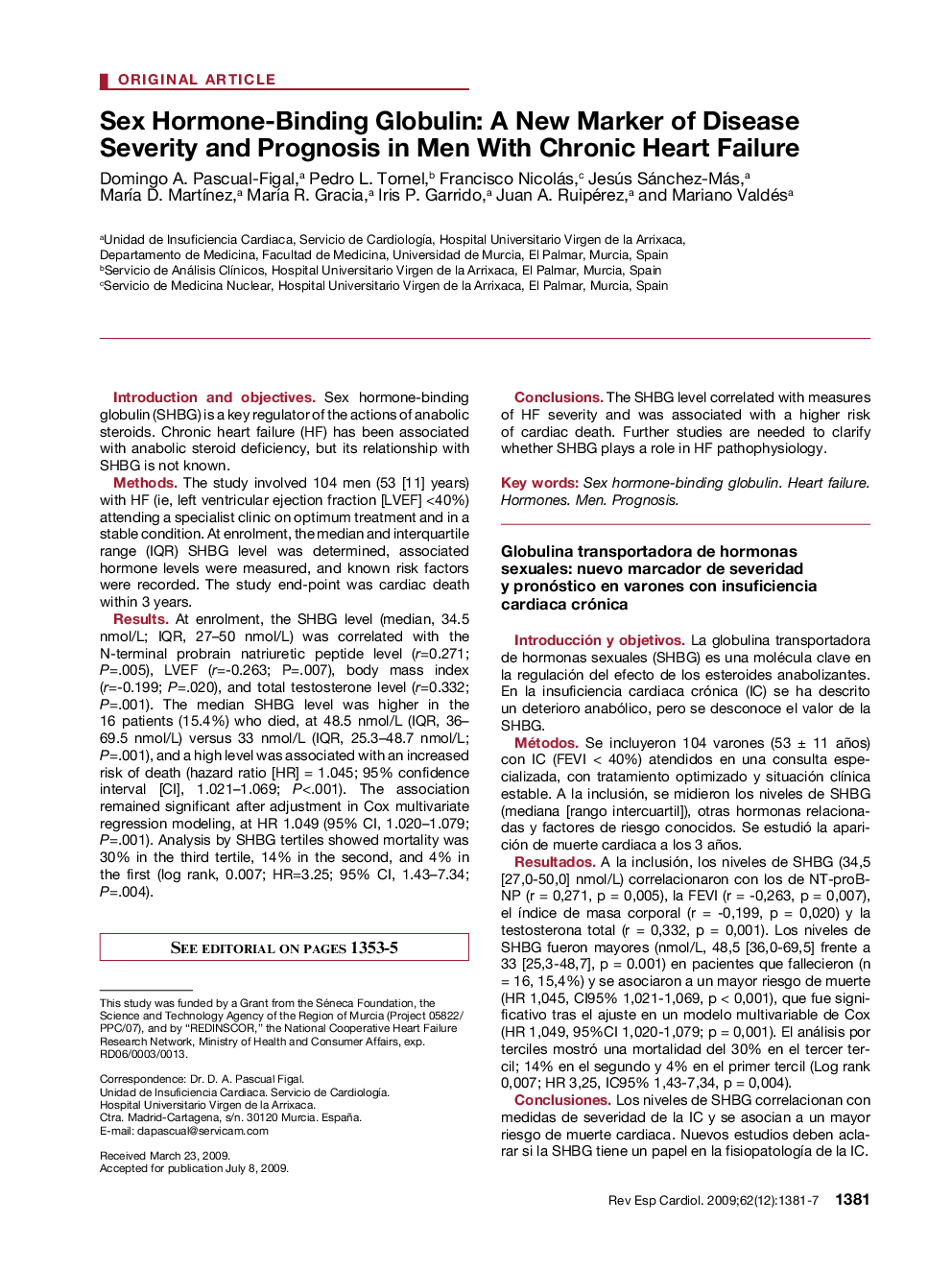| Article ID | Journal | Published Year | Pages | File Type |
|---|---|---|---|---|
| 3018827 | Revista Española de Cardiología (English Edition) | 2009 | 7 Pages |
Introduction and objectivesSex hormone-binding globulin (SHBG) is a key regulator of the actions of anabolic steroids. Chronic heart failure (HF) has been associated with anabolic steroid deficiency, but its relationship with SHBG is not known.MethodsThe study involved 104 men (53 [11] years) with HF (ie, left ventricular ejection fraction [LVEF] <40%) attending a specialist clinic on optimum treatment and in a stable condition. At enrolment, the median and interquartile range (IQR) SHBG level was determined, associated hormone levels were measured, and known risk factors were recorded. The study end-point was cardiac death within 3 years.ResultsAt enrolment, the SHBG level (median, 34.5 nmol/L; IQR, 27–50 nmol/L) was correlated with the N-terminal probrain natriuretic peptide level (r=0.271; P=.005), LVEF (r=-0.263; P=.007), body mass index (r=-0.199; P=.020), and total testosterone level (r=0.332; P=.001). The median SHBG level was higher in the 16 patients (15.4%) who died, at 48.5 nmol/L (IQR, 36–69.5 nmol/L) versus 33 nmol/L (IQR, 25.3–48.7 nmol/L; P=.001), and a high level was associated with an increased risk of death (hazard ratio [HR] = 1.045; 95% confidence interval [CI], 1.021–1.069; P<.001). The association remained significant after adjustment in Cox multivariate regression modeling, at HR 1.049 (95% CI, 1.020–1.079; P=.001). Analysis by SHBG tertiles showed mortality was 30% in the third tertile, 14% in the second, and 4% in the first (log rank, 0.007; HR=3.25; 95% CI, 1.43–7.34; P=.004).ConclusionsThe SHBG level correlated with measures of HF severity and was associated with a higher risk of cardiac death. Further studies are needed to clarify whether SHBG plays a role in HF pathophysiology.
Introducción y objetivosLa globulina transportadora de hormonas sexuales (SHBG) es una molécula clave en la regulación del efecto de los esteroides anabolizantes. En la insuficiencia cardiaca crónica (IC) se ha descrito un deterioro anabólico, pero se desconoce el valor de la SHBG.MétodosSe incluyeron 104 varones (53 ± 11 años) con IC (FEVI < 40%) atendidos en una consulta especializada, con tratamiento optimizado y situación clínica estable. A la inclusión, se midieron los niveles de SHBG (mediana [rango intercuartil]), otras hormonas relacionadas y factores de riesgo conocidos. Se estudió la aparición de muerte cardiaca a los 3 años.ResultadosA la inclusión, los niveles de SHBG (34,5 [27,0-50,0] nmol/L) correlacionaron con los de NT-proBNP (r = 0,271, p = 0,005), la FEVI (r = -0,263, p = 0,007), el índice de masa corporal (r = -0,199, p = 0,020) y la testosterona total (r = 0,332, p = 0,001). Los niveles de SHBG fueron mayores (nmol/L, 48,5 [36,0-69,5] frente a 33 [25,3-48,7], p = 0.001) en pacientes que fallecieron (n = 16, 15,4%) y se asociaron a un mayor riesgo de muerte (HR 1,045, CI95% 1,021-1,069, p < 0,001), que fue significativo tras el ajuste en un modelo multivariable de Cox (HR 1,049, 95%CI 1,020-1,079; p = 0,001). El análisis por terciles mostró una mortalidad del 30% en el tercer tercil; 14% en el segundo y 4% en el primer tercil (Log rank 0,007; HR 3,25, IC95% 1,43-7,34, p = 0,004).ConclusionesLos niveles de SHBG correlacionan con medidas de severidad de la IC y se asocian a un mayor riesgo de muerte cardiaca. Nuevos estudios deben aclarar si la SHBG tiene un papel en la fisiopatología de la IC.
